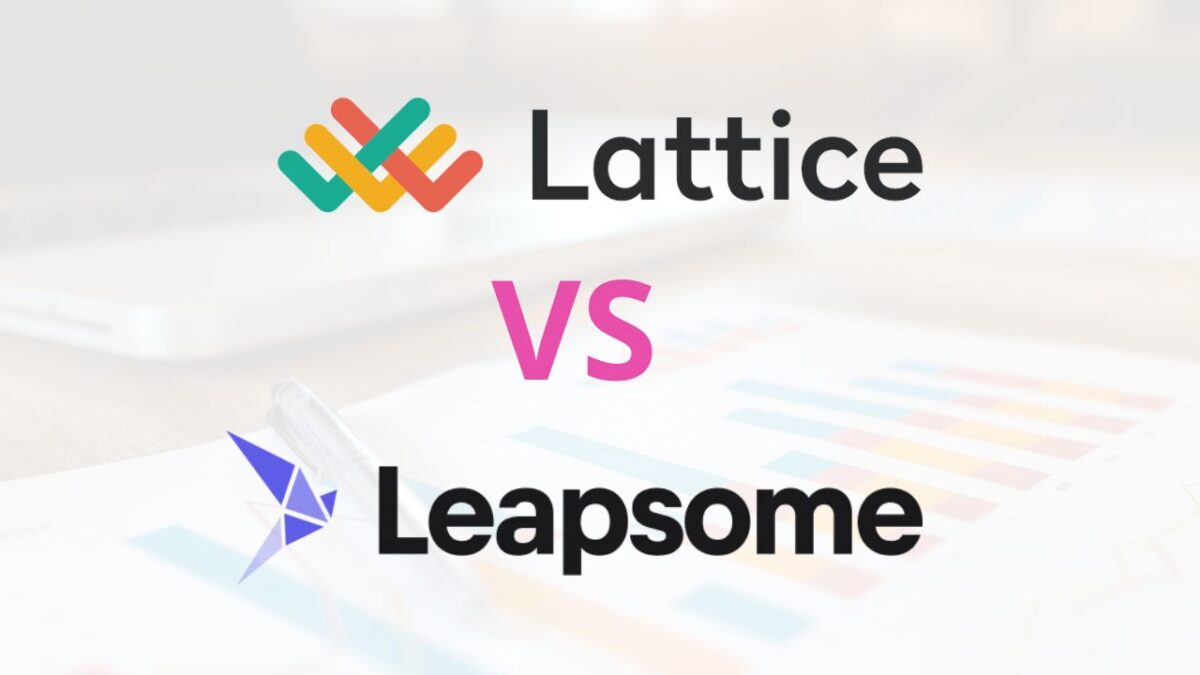As a business grows and faces new challenges, HR leaders like to employ technology to improve performance, increase employee engagement, and support the success of both the employee and the organization. The tools they choose are key to determining their success and growth.
The most prevailing tools for these tasks are Lattice and Leapsome. Both offer strong features for managing performance, raising engagement, and reinforcing learning. But which one is most suited for your business goals? Determining the right platform, however, can be tricky.
This guide compares Lattice vs. Leapsome to help you choose the best option.
What is Lattice?
Lattice is an all-around people management platform. It uplifts employee engagement and organizational development. HR professionals usually employ this tool to align employee goals with company objectives while fostering continuous feedback and recognition.
Key Features of Lattice
- Performance Reviews: Customizable review processes to fit your organizational needs
- OKRs and Goal Tracking: Real-time tracking of team strategies to meet company goals
- Employee Engagement Surveys: Understand employee opinion and response to feedback
- Analytics and Reporting: Data-driven discernment to help HR make the right decisions
- 1:1 Meetings: Schedules to promote open and productive communication
- Career Development Plans: Tailor-made plans to support employee growth and development
Lattice Ratings and Reviews
- G2: 4.7/5 (3,890+ reviews)
- Capterra: 4.5/5 (180+ reviews)
What is Leapsome?
Leapsome is a flexible people management platform. It offers features to improve employee performance and engagement. Its modular technique helps companies select the features that serve their individual needs.
Key Features of Leapsome
- Performance Reviews: Flexible review cycles with automated workflows
- Learning Management: Integrated tools for employee training and upskilling
- Employee Surveys: Feedback tools to measure employee satisfaction and engagement
- Goals and OKRs: Frameworks for aligning individual and team objectives
- Feedback and Recognition: Real-time feedback to elevate morale and productivity
- Onboarding: Comprehensive onboarding tools to set employees up for success
Leapsome Ratings and Reviews
G2: 4.9/5 (1,770+ reviews)
Capterra: 4.6/5 (70+ reviews)
Lattice vs. Leapsome: Feature Comparison
| Feature |
Lattice |
Leapsome |
| Performance Reviews |
Customizable cycles |
Automated workflows |
| OKRs and Goal Tracking |
Real-time tracking |
Goal alignment frameworks |
| Employee Engagement |
Surveys with actionable insights |
Feedback tools with survey templates |
| Learning Management |
Not available |
Built-in Learning Management System |
| Onboarding |
Limited functionality |
Comprehensive onboarding tools |
| Analytics and Reporting |
Advanced data visualization |
Comprehensive reporting tools |
Usability and User Experience
While both Lattice and Leapsome produce equivalent qualities and uncomplicated interfaces, they are still slightly different in terms of target audience:
Lattice: It is most suitable for medium to large business institutions focusing on performance management.
Pros of Lattice:
- Individual measures of performance control
- Integral progressive analytics for materials decision-making
- Highly customizable workflows
Cons of Lattice:
- Rigid learning and employee onboarding solutions
- Priced slightly higher than other brands in the market
Leapsome: It prefers flexibility and modularity while being reasonable, making it a more acceptable choice for smaller companies or startups.
Pros of Leapsome:
- Reasonable modular pricing
- Active learning and development features
- Easy integration with existing tools
Cons of Leapsome:
- Analytics are not as developed as Lattice
- Difficult to do as effectively for large organizations
User Feedback: What People Think About Lattice and Leapsome
- Lattice has transformed how we handle performance reviews and goal tracking. (Source: G2)
- Leapsome focuses on employee development and has improved our team engagement. (Source: Capterra)
Pricing Comparison
Both applications work according to the subscription method. However, their costs vary depending on options and number of users. Indeed, pricing transparency may mean having to talk to sales representatives.
| Platform |
Price |
Key Pricing Details |
| Lattice |
- Talent Management: $11/month per seat
- HRIS: $10/month per seat
|
Custom pricing for advanced features |
| Leapsome |
Starts from $8/month per user |
Modular pricing for feature add-ons |
Integrations
- Lattice: Integrations with Slack, Microsoft Teams, BambooHR, and Workday.
- Leapsome: Integrations with Jira, Slack, Google Workspace, Personio, and more.
Ideal Use Cases
Lattice:
- Mid-to-large enterprises that want an all-in-one performance and engagement tool
- Companies that value advanced analytics and alignment on goals
Leapsome:
- Startups and small to midsized leverage flexibility
- Organizations focusing on learning and development
Lattice vs. Leapsome: Feature Comparison Study
To provide more insight into how Lattice and Leapsome operate, explore some of their most impactful features:
Performance Reviews
Both platforms work excellently in performance reviews but approach them differently:
- Lattice: This delivers a highly flexible review pattern. It provides a configurational perspective, sets templates, and introduces weighted competencies with complex feedback frameworks.
- Leapsome: This tool is concerned with automation and usability. It automatically schedules team reviews and connects Goals & OKRs for evaluation.
OKRs and Goal Tracking
OKRs (Objectives and Key Results) are essential to keeping the teams aligned and results-driven. Both platforms allow HR leaders to implement OKRs effectively:
- Lattice: Lattice provides agile real-time goal-setting tools. It also includes enhanced goal-tracking dashboards.
- Leapsome: Leapsome encompasses systems that guide the managers and the employees to connect personal needs and accomplishments to organizational goals and results.
Analytics and Reporting
Data is the backbone of today’s human capital strategies, and both solutions feature powerful analytical tools.
- Lattice: It is easy to use and also offers better visualization tools so that the HR leaders can analyse trends, engagement scores and even forecast the outcome of the workforce.
- Leapsome: Leapsome provides comprehensive reporting tools that are simpler yet effective, focusing on actionable insights.
Learning and Development
In this area, Leapsome has a clear advantage:
- Leapsome: This includes an easy-to-use learning management system (LMS) for creating and assigning training materials. This feature is for organizations that emphasize re-skilling their employees.
- Lattice: LMS is missing, meaning that organizations might need to seek additional solutions for integration into their system.
Real-World Applications
Lattice Case Study: Slack
Slack is one of the best teamwork hubs. It is improving its performance management processes by implementing Lattice for a growing team in the short run. By adopting Lattice, Slack made significant progress:
- Improved Performance Reviews: Lattice facilitated structured and efficient performance assessments, resulting in a 40% increase in employee satisfaction.
- Improved Goal Alignment: The platform streamlined a more satisfactory alignment of personal goals with company objectives, resulting in a 35% increase in goal completion rates.
- Increased Feedback Frequency: With its continuous feedback instruments, Slack witnessed a 50% upgrade in peer-to-peer evaluation exchanges, cultivating a culture of steady improvement.
These results prove how Lattice helps in performance management and enhance engagement at Slack workplace.
LeapsomeCase Study: SIDES
SIDES is a growing company in the food delivery and restaurant management sector. As the organization grew, it aimed to create a scalable HR system centered on employee development, a strong feedback culture, and career progression.
- Competency Framework Implementation: SIDES introduced a competency framework through Leapsome, allowing personalized development plans for employees. In the first three months, more than 90 per cent of employees actively participated in the competency inspection.
- Enhanced Feedback Culture: SIDES created a culture of open communication with Leapsome feedback tools. The co-worker communication increased to around 104 times in the first month only, involving feedback and praise.
- Improved Performance Reviews: They got historical performance data and constant feedback. There was an improvement in the accuracy of the performance reviews by 30%, thus minimizing the chances of recall bias.
Conclusion
It is the needs and requirements of your team that help you choose between Lattice and Leapsome. Both platforms have effective tools that enable employees to engage and grow, but they differ in some strengths and features.
Lattice is best suited for a company seeking an all-in-one performance management system featuring strong capabilities for feedback, goal-setting, and development. However, if you want a more flexible and customizable system, go for Leapsome. It offers valuable assistance in onboarding learning and performance management in your organization.
Both tools are indeed best in their way and help in forming a more engaged and productive team.
But if you want something that integrates features of both platforms and goes one step further, you should consider Engagedly. With its range of tools, Engagedly allows an HR leader to engage seamlessly through performance and growth.
You can also schedule a demo to get better clarity and make the best decision.
FAQs
1. What is the best platform for the training and development of employees?
Leapsome’s integrated learning management tools make it unique.
2. Are startups able to use these platforms?
Yes, startups can use both platforms. However, Leapsome is more startup-friendly due to its flexible price structure.
3. It is possible to integrate Leapsome or Lattice with other HR systems?
Integrations available on both Lattice and Leapsome include Slack, Jira, and BambooHR.
4. How do Lattice and Leapsome approach user onboarding?
Lattice has available onboarding features, and so does Leapsome, but the features with Leapsome are more extensive.
5. What industries use Lattice and Leapsome?
Lattice has uses in various industries, including computers, human resources, communication, public safety, security, defense, automotive, aerospace, and healthcare. Conversely, Leapsome caters to sectors including machine learning, fintech, and artificial intelligence.
6. How do Lattice and Leapsome handle feedback?
Lattice has a set of weekly or bi-weekly meetings with specific topics, while Leapsome fosters an open conversation during the work process.
Gabby Davis
Gabby Davis is the Lead Trainer for the US Division of the Customer Experience Team. She develops and implements processes and collaterals related to the client onboarding experience and guides clients across all tiers through the initial implementation of Engagedly as well as Mentoring Complete. She is passionate about delivering stellar client experiences and ensuring high adoption rates of the Engagedly product through engaging and impactful training and onboarding.






